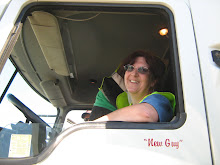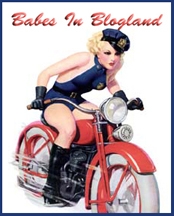Well, actually we didn’t, but we went to Houston next and one should never waste a good line.
Houston is even further south than Dallas. There were palm trees; the grass was green, properly green. Driving south in the winter, you can plot your progress by the grass. To start with there is just snow, then gradually there is less snow until bits of grass show through, but it is brown, dormant, winter grass. A state or two later there is brown grass and no snow at all. Then, as time passes there will be a hint of green here and there, a tiny spot of a shoot under the dead stuff. The patches of green-under-brown might get a bit bigger in sheltered areas, but real, proper grass in winter was a first.
There was a slight, mild breeze under a clear, sunny sky. We were still in T-shirts and sawn-offs, sitting outside enjoying the fabulous warmth, as the forklift driver loaded our trailer with pallets of resin, destined for Toronto. Each time he had to pop outside, he raised the furry-edged hood of his parka. We watched, bemused for a while. Was it some sort of safety precaution? Not the little breeze surely? Maybe this smidgeon of air movement passes for winter in Texas.
Did Texans remain friendlier than Georgians? In person, yes. Unfailingly charming, friendly and chatty, we discussed accents, weather and food with all and sundry. Everyone makes eye-contact here, giving a sense that some real communication is going on, which eases the doing of business when you’re asking stupid questions again and double-checking accent-related confusions on both sides. As we drove further into the state though, another side of Texans began to emerge, they are all Nascar wannabees behind the wheel.
The only discernable similarity between driving an ambulance and driving a truck relates to the behaviour of other road users when they see you coming. Most normal driving populations divide roughly equally into three categories; those who see you, observe a signal and opt to leave room for you do whatever-it-is, those who see the same and opt to have a little race instead, and those who don’t see you until they freeze, like deer in the headlights. The spread varies a little. England probably has a few more freezers, Canada, a few more polite people (except for Montreal of course). Most of the US appears to have a relatively normal spread but not those pesky Texans. Will they let a hapless 18-wheeler make a lane change? No they will not. The moment that indicator goes on, everyone on the road puts pedal to metal; the road as metaphor for life and no Texan ever gets left behind.
We emerged from the tangle of racetrack ringroads with our resin on Monday afternoon. I drove until my legal (in the US) workshift ended, then Neil took over and drove through the night. This consignment was due to cross the border with a newfangled sort of customs clearance which neither of us had attempted before. It required a newfangled sort of ID card from Homeland Security confirming one as unlikely to be a terrorist (the one that Homeland Security in Baltimore hadn’t heard of). I have mine, but Neil’s is still in the mail, so it was imperative that I be in the driving seat when we attempted to bring the truck back into Canada.
Now, in order to be able to drive legally in the US, one needs to have had ten consecutive hours off duty, but in Canada one can split those ten hours into two periods of rest, so long as one of them is eight hours or longer consecutively. (Have you got that? I’ll be asking questions later and it gets more complicated.) So what with one thing and another we calculated that, although Neil had to have ten hours before driving again, I could get away with eight so long as I took over again at the duty free stop before the bridge to Canada in Detroit, because we weren’t in the US any more. Just as long as we timed this for midnight, because in Canada your rest time has to be in the same 24 hour period, although in the US it doesn’t. (Aargh.)
Calculations checked and rechecked for legality, we kept the truck rolling round the clock and arrived at the border at midnight on Tuesday. Neil drove as far as Memphis, I took us on through Nashville to Indianapolis. I scanned the radio channels excitedly, hoping for some traditional country music stations and songs with lyrics you can laugh about, but, despite the road signs for attractions with the names of local music stars all I found to tune into were gospel stations, with more sermons than music. I do want to visit the Loretta Lynn Dude Ranch though, if only to find out what a dude ranch is. I thought I knew what a ranch was, and what a dude was, but if you can have a thing called a dude ranch, then the versions in my head don’t quite fit.
The snow began somewhere around Indianapolis, as did the radio stations with weather warnings, we were definitely heading back north and it was Neil’s turn to negotiate Detroit in the obligatory blizzard. At the entrance to the Ambassador Bridge to Windsor we swapped seats and checked and rechecked the paperwork, cards, barcodes and rules for electronic preclearance of goods into Canada. The helpful flowchart, supplied by Challenger for its employees (please bear in mind that there are at least eight different types of customs clearance for freight, all with different procedures which must be followed to the letter) managed to make this version look very simple. Give the customs officer three cards with barcodes on. We were sceptical, no faxing bills of lading to brokers, no sending of satellite messages to customs experts, no scribbling of massively long numbers on bits of paper, no bonds to fail at the last moment.
I lined up all available bits of paper, ready for when things went wrong, fixed on the polite face that answers all stupid questions without a trace of irritation, and proceeded to the window. The rules go; wait until the previous truck has completely cleared your lane, pull up slowly making eye contact if you can, match your window to the booth exactly, switch off engine, do not set brakes, remove sunglasses and prepare to be humiliated. I presented the three cards with barcodes on. It really was that simple. A few relevant and non-insulting questions, how long had we been away, did we have anything to declare, was anyone hidden in the sleeper (well that one was a bit daft but nothing compared to 'how do you two know each other?') then we were cleared to go. Amazing, the easiest yet. I will happily move resin about the world again, I may not know quite what it is but it’s so much less trouble than beer or honey.
A few days off now, some serious catching up on sleep to do, then out again on Monday. It’s snowing.






Hi Rocky -
ReplyDeleteA dude in western American English is also a tenderfoot, a newby, a wannabe, ie. someone who is not at Home on the Range. And a ranch is a business that raises livestock, rather than crops. Dude Ranches were set up for Easterners to go on holiday, ride horses, and hang out with cowboys. I remember stories about dude ranches in Nevada that catered to easterners who were there to get a 6-week divorce and have some fun as well.
Enjoying reading your blog!
FarWestErica
Brill Erica, now I know. Thanks.
ReplyDeleteWith regards resin, I know of it as used by violinists on their bows, and weightlifters and gymnasts on their hands. Sticky stuff. Comes from trees.
ReplyDeleteI suspect this probably wasn't what you were transporting though.
Ed